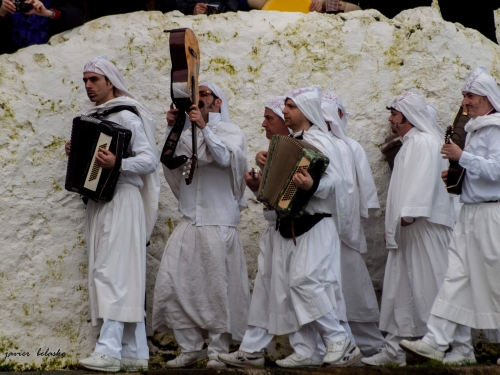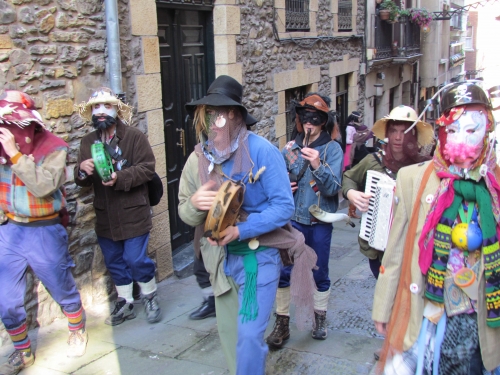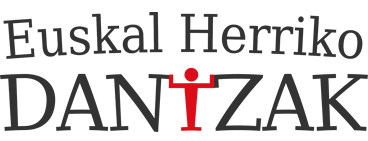Carnival celebrations past and present
- Emilio XABIER DUEÑAS
- 01/ 06/ 2001
This article looks at carnival celebrations, ranging from how they were in earlier times to the problems with the use of masks, collections and other ritualistic elements.

Traditional winter festivities in Bizkaia
In the Basque Country or Euskal Herria, where these traditions have been maintained or recovered through word-of-mouth reports, carnival celebrations are characterised by the blending of a variety of aesthetic elements with symbology and popular representations. They are found all over the country.
The differences between carnival celebrations in one place and another are not based mainly on location but on other reasons. In Bizkaia, as in the other Basque territories, many older carnival traditions survived until the beginning of the 20th century. However by that time industrialisation and the resulting emigration were already undermining their preservation.
Between 1920 and 1930 carnival celebrations were prohibited, sometimes in part (e.g. a ban on wearing masks) and sometimes altogether. In part this was due to the church, as its struggled against what it considered to be a pagan celebration, and in part to the political situation: as power changed hands between the republic, the monarchy and the dictatorship, the eagerness of the majority to enjoy themselves was taken advantage of in the cities by assassins to commit attacks from behind carnival masks.
House to house collections
The cycle of events leading up to carnival celebrations takes place in winter. On Basque farmsteads, pigs were traditionally slaughtered between mid November and February or March, and this marked the beginning of a time centred around obtaining the products which would subsequently be used as food for the inhabitants of the house and as gifts for the groups of postulants who travelled from house to house around the farms and villages. These groups enjoyed the hospitality of local people, often involving eating and drinking to excess in a typical manifestation of the carnival spirit.
Autumn and winter cattle fairs were followed by the Christmas festivities and by house to house collections by children and youths for money under various names, including Marijesiak or Abendua, Christmas boxes, Urte barri and gifts for epiphany or Erregen eguna, following pre-set routes through outlying districts and along mountain paths. All these events were accompanied by family gastronomic rituals at which particular foods not eaten for the rest of the year were eagerly devoured.
After Christmas came St. Anthony's Day, a time for the blessing of animals and the auctioning of foodstuffs. After that came Candlemas with its blessings of candles and its biscuits and sweets; St. Blas' Day, when a cord properly blessed and worn around the neck could ward off throat ailments; and St. Agatha's Eve, when the rhythmical beating of the long sticks known as makilas broke the silence of the night in dark hamlets and outlying farmsteads and in the bustling, fire-lit village streets.
Collections were also held on the last day of February or the first of March under the name Marzas. These collections were made by marceros dressed in skins and carrying bells and holly branches festooned with multi-coloured ribbons.
Prelude to the grand finale
Carnival celebrations in Bizkaia have gone under various names: in Spanish the most common are carnaval, carnavales and carnestolendas. In Basque, depending on the dialect, the names most widely used are karnabalak, aratuzteak, aratosteak, ateste eguna and anarru eguna.
The core events of carnival time in Bizkaia began traditionally with a meal eaten outdoors. Small groups of children and youths would set out for the nearest meadow and light fires, where they would cook chorizo sausage, bacon and eggs. The name by which that day was known usually referred to the type of food eaten (txitxiburduntzi, sasikoipetsu and sarteneko) or to the place where the meal was consumed (basa(ra)toste, kanpora martxo and sasi martxo).
The next day of celebration was, and in some villages in the Durangaldea and Arrankudiaga areas still is, Jueves Gordo (literally "Fat Thursday"), known in these parts as Eguen zuri. On that day schoolchildren went from neighbourhood to neighbourhood carrying a live rooster or a placard with a drawing of a rooster, singing verses typical of that day and collecting money which they spent on a tea. In the Encartaciones area a similar collection, known locally as carrastoliendas, took place on Shrove Tuesday.
Dressing up and special events
Dressing up is probably the first thing which is typically associated with carnival celebrations. Any outfit that broke the monotony of ordinary days was good for celebrating this, the queen of winter festivities, when the normal habit of work, formality, food and, to some extent, religiosity, was thrown off. The catalogue of traditional disguises includes those of peasant, rich man, nanny, bear or hartza and the odd, shirted character known as atorra, which can still be found in Mundaka. Both sexes seized the opportunity to break with usual roles by cross dressing in an exaggerated confirmation of the advantages of the way relationships stood within the community.
Up to the 1930's the mask was a typical feature: concealed behind it, people could give rein to thoughts and attitudes which they kept hidden during the rest of the year. home-made cardboard and elegant rented masks, bags and cloths hand painted with disjointed features (karatulak, marrauek, kakoxak, surraundiak and errabidxek among others) were all accepted as part of the masquerade as people let their hair down. Behind them, girls and boys could be pursued unashamedly. There was however a superstition which said that masks must be removed while dancing, as otherwise they would stick to the face for ever.
Carnival was also a time when special foods were prepared: the dishes which no home could afford to be without included pigs' trotters and ears cooked in Biscayne sauce. This was followed by special toast for dessert made from bread or flour and milk (fotak and aidxe, respectively). These desserts were particularly eagerly awaited by the youngest members of the household.
The favourite entertainments of the fancy-dressed carnival-goers were music and dancing. Associations were formed which wrote their own songs and accompanied them on their own instruments, selling lyric sheets to cover their expenses during the festivities. They would travel through the villages on foot or in carts with their guitars and mandolins. Music for dancing was provided by txistulari flute players, accordionists or by the local village band, either in the village square or in a hall. These were the leading collective celebrations of the time.
Perhaps out of the desire to revitalise these old traditions, some towns and villages have revived certain typical carnival festivities and other recreational and celebratory events during the carnival period and at other times as socio-cultural activities.








